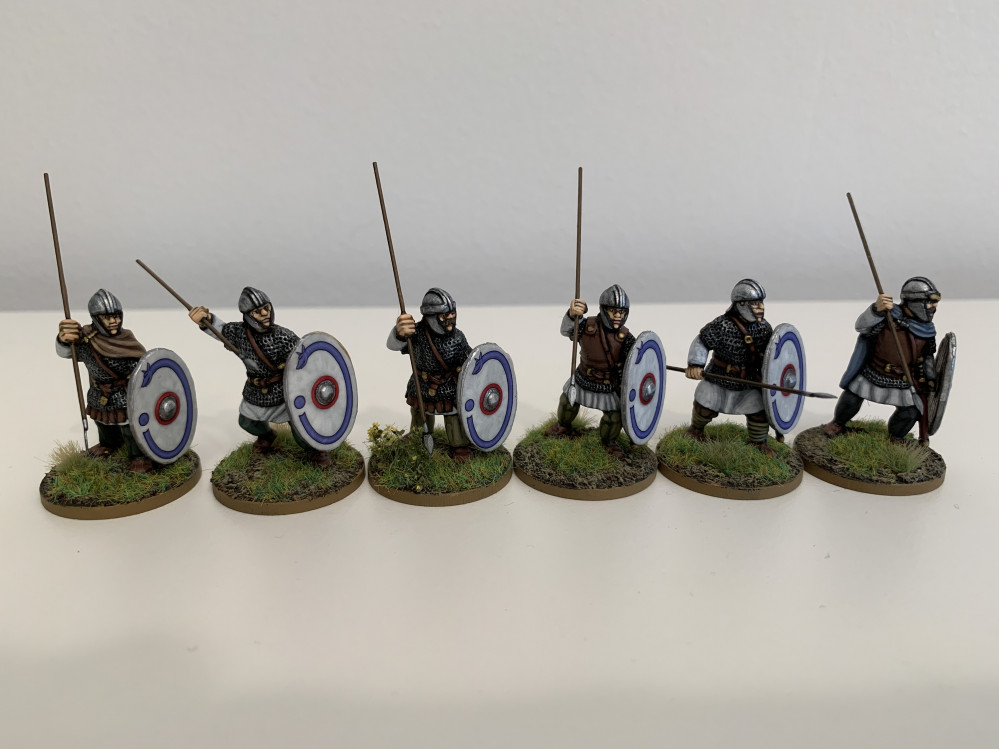
Romano-British for Dux Britanniarum
Battle Report - Raid on a Border Tower - Assessment
It’s been a few months since I played this game and so I’ve written this battle report on the basis of my notes and the pictures I took at the time. However, I have to say that I thoroughly enjoyed it back in November and found myself reliving the excitement as I was writing.
There were four pivotal moments in the game. The first was Ceawlin’s devastating charge which eliminated two-thirds of Peredur’s escort in turn two. At that point Garcianus and Urien had barely got the rest of the British force moving and it seemed unlikely they would be able to recover the situation.
However, a series of good move rolls and timely activations meant that Garcianus and Peredur were able to meet in the centre of the table and see off the attack by Berthun the Devil in turn four. I had expected Garcianus’ attack on Saebert’s force in turn five to be more devastating than it actually was. However, as it turned out, the effect of a Carpe Diem card and all the following cards was only enough to offset the effect of casualties, shock and superior forces on the Saxon side. That said, if Garcianus had not made that intervention when he did, the Saxons may have been able to bring superior forces to bear later in the game.
As it was, the sacrifice of the warriors and Comanipulares meant that the stage was set for the Levy to come up and put the depleted remnants of Saebert’s command to flight. Things might have gone differently if Ceawlin had managed to make a better move roll and join the fray, but as it was, Urien Cadwallader and his band of raw amateurs managed to time a charge at exactly the right moment to bring Saxon Morale to zero.
I learnt a lot from this game, but three things stand out:
- Terrain matters. Intervening obstacles played a significant role in reducing movement at key moments. Peredur’s force was left hanging in front of a drystone wall, whilst a hedge kept Ceawlin from joining the last fight with the Levy. Obstacles also forced groups into smaller gaps, reducing the number of men they could commit to the fight.
- Keep rallying off the shock. Having nobles remove shock was crucial to keeping groups in the fight. The British did this more than the Saxons and it showed in the way they were able to keep the depleted warriors and Comanipulares fighting down to the last man. In contrast, the Saxons had fewer opportunities to rally off shock which left them vulnerable to a counter-attack.
- Barbarians don’t always need to charge. I was probably over aggressive with the Saxons, in part driven by the need to try and capture Peredur before he could be supported by the rest of the British force. As such, formations attacked piecemeal, with never more than two groups brought to bear at one time. I might have been better off taking a bit of time to dress the ranks and create a more organised attack of three or more groups, thereby creating a better chance of punching a hole in the British line. Such an approach would also have given the Saxon nobles more of an opportunity to rally off shock before it became an issue.
Overall, I felt it was a pretty good simulation of Dark Ages warfare, with the role of the nobles critical to the execution of attacks. The fact that a well organised band of Levy could see off a group of Hearthguard, but only after the latter had been suitably worn down, also felt like a realistic result and showed that even the weakest troops have a role to play in the warband. Next time I shall try to find a more fully-engaged opponent as I think solo play may accentuate my instinctive bias to the underdog British. I shall have to get to work on some new terrain such as a church or town gates in order to play out some of the other raid scenarios in the rulebook. After all, Ceawlin needs to raise some money fast!































![TerrainFest 2024 Begins! Build Terrain With OnTableTop & Win A £300 Prize! [Extended!]](https://images.beastsofwar.com/2024/10/TerrainFEST-2024-Social-Media-Post-Square-225-127.jpg)










































2022-03-08 Your project has been visited by the unofficial Hobby Hangout. Huzza!